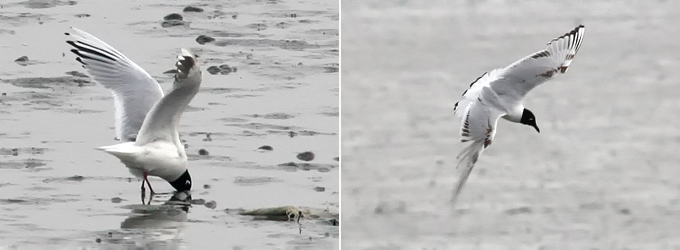 | E-mail to Birds Korea |
 | KWBS |
in the Region
 | The Oriental Bird Club |
 | BirdLife International (Asia) |
June
Often hot (temperatures up to 30°C inland) and humid, with very heavy rains some years by mid-month.
By early June, Yellow and the rare Schrenk's Bittern are breeding in reed-beds, and Watercock give their (slightly comical) gulping calls in the best rice-field areas. Nesting activity in Black-faced Spoonbill and Chinese Egret colonies reaches its peak, and forest nesters are still vocal, especially in the first half of the month. At Gwangneung, typical species include 4 species of woodpecker, Ruddy Kingfisher, Yellow-rumped Flycatcher and Mandarin Duck, while on the south coast at Geoje Island Pale Thrush, Blue-and-white Flycatcher and Yellow-throated Bunting predominate. Black Woodpigeon nest on Gageo and other islands and Styann's Grasshopper Warbler are widespread on small islets: both species, plus the very local Russet Sparrow, can be seen well on Ulleung Do.
(The following records are a compilation of our own sightings and records sent in by other observers. As well as being posted on the Birds Korea website(s), selected records are also forwarded to other Korean-language birding websites; records of threatened species are arranged and forwarded to Birdlife International and national authorities when appropriate; flag images and records are passed to bodies responsible for their coordination throughout the flyway; and all records sent to us are used to compile annual reports and to support the evolving understanding of the status of many of Korea’s birds.)
Cheorwon basin, June 27
A search for Shrenck's Bittern at a once reliable site produced 15 sightings of Yellow Bittern in the first two hours, and a single Chinese Pond Heron: the area appears to be too disturbed by fishers now for the rather shyer Shrenck's.
At another rather smaller reservoir, an apparent attempt at zoning has concentrated fishers along a concrete bank, leaving one well-vegetated edge - and a male Shrenck's was seen within 5 minutes of arrival. Also there were 8 Mandarin and a single Little Ringed Plover. Other species of note in the area were at least 3 Ruddy Kingfisher heard, 2 Chinese Sparrowhawk, 2+ singing Grey-backed Thrush, and a juvenile Siberian Stonechat.
On the way back to Incheon, at least 3 Mongolian and 3 Black-tailed Gull were seen along the Han-Imjin.
Gaya San and Yanggu County, June 26
A damp morning at Gaya San produced very brief views of a single Hazel Hen in flight, a glimpsed Grey-backed Thrush (very skulking despite some passionate singing!), brief views of an Indian Cuckoo (with probably 3 others heard) and a White-backed Woodpecker (DN only), and most surprisingly (and significantly) a flock of 6 or 7 Eurasian Siskin (with 2 or 3 juveniles, based on paleness and streakiness of plumage, and one adult seen well enough to age). There are no June/July/August records listed for this species in Park's unpublished doctoral thesis on the status of birds in South Korea, and no clear evidence of over-summering or breeding given in Tomek's review of records in the DPRK.
At Yanggu, guided by Barry Heinrich (many thanks!), excellent views of one adult and one juvenile Eagle Owl, as well as more singing Grey-backed Thrush and a single singing White's Thrush.
Eocheong Island and Gaya San Provincial Park, June 25
Spells of heavy rain in the early morning eased, so that the ferry journey and the hour (!) on the island was dry. From the ferry, a single immature Heuglin's Gull (ssp unknown) in the Geum River (exceptional summer record), and only 6 Streaked Shearwater on the way out, while the return journey produced a Slavonian Grebe just offshore from Eocheong (perhaps first summer record for Korea, and believed a first for the island), a single (poorly imaged) Short-tailed Shearwater and 2 Swinhoe's Storm Petrel (sadly, last by NM only).
On the island itself, ca 4 or 5 Pleske's/Styan's Grasshopper Warblers heard in song, with one seen song-flighting and another seen perched, excellent views of a singing Korean Bush Warbler, single Japanese Bush Warbler, several White-eye sp (considered most likely to be Japanese), single Cattle Egret and Grey Starling, and a Northern Hawk-cuckoo heard briefly.
At Gaya San, light evening rain prevented much birding, but most noteworthy species included 6 Mandarin Duck, 4+ Indian, 3+ Oriental/Horsfield's, and 3+ Common Cuckoos, and 3 Grey-backed and 5+ Pale Thrushes in song.
Kunsan vicinity, June 25
Peter Nebel located a Chinese Pond Heron on the previous weekend. PN reported two, although I could observe only one. Fortunately for me one stuck around and continues to stick around the rice fields behind the nurses college in Kunsan to be observed on the 24th and 25th.
The Little Tern colony in the industrial zone is very active. Perhaps Kentish Plovers and Eurasian Oystercatchers are breeding there for now, too. At the Keum I counted 260+ Far Eastern Curlews. A Hoopoe was seen near the Geum and Grey-backed Thrush continue to sing around Oh-seong. Japanese Bush Warblers sang in the vicinity of Okku.
Yeongjong Island - Seosan Lake A and B, June 24
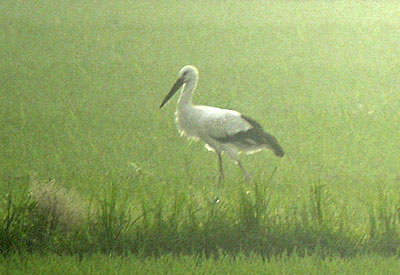
In warm and fair conditions near the airport, in a building zone, a colony of at least 120 Saunders's Gulls, frequently dreading at passing Grey Herons or vehicles. With some adults apparently still sitting (?), only 2 or 3 fresh juveniles were noted. On the southern tidal-flat, also disturbed by construction work, ca 5 Chinese Egret and 2 Mongolian Gull.
Further south, at Seosan Lake A, good views of an oversummering Oriental White Stork (perhaps a second calendar year bird, this is apparently the first, or one of the first, to oversummer since the early 1980s: Park, 2002), as well as a single female Baikal Teal and a Common Shelduck, 5+ Goosander, 10 + Mongolian Gull, a male Watercock and 2 or 3 Whiskered Tern.
Gangwha island, June 24
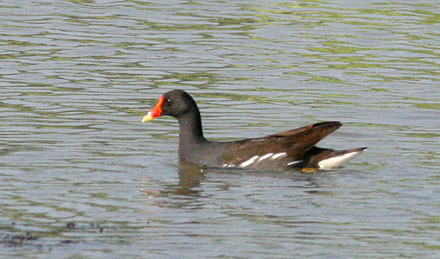
2 Chinese Egrets provided a comical spectacle on the southern mudflats today - 1 sprinting along the waters edge with its neck held on its side, eyeing fish before plunging into the water crazilly. 4 Black-faced Spoonbills sieved the water nearby. Also present, c.300 Far-Eastern Curlews, with 1 Whimbrel and a scattering of Eurasian Curlews, 2 Mongolian Gulls, and 10 Great Cormorants.
Reedswamp inland provided several Zitting Cisticolas, plentiful Cattle Egret, Oriental Reed Warblers, a Common Kingfisher, Barn Swallows, and 4 Common Moorhens (surprisingly scarce in Korea), and abundant signs of Chinese Water Deer.
Woodland areas held typical summer birds: a Black-naped Oriole, a flock of 70 Grey Starlings, Eurasian Cuckoos and a Chinese Sparrowhawk (seen catching and dismembering a frog).

I was shocked to find that the patch of prime habitat, a reedy area (that last year held Yellow and Shrencks Bitterns, Chinese Pond Herons and Common Kingfishers) has been opened up for recreational use. 2 new roads ring the marsh, fishermen crowded the banks, and traffic rumbled around it.The upper reaches have had concreting along the edges.
Only a year ago this area was undisturbed and untouched. Today it was devoid of birds.
Gunsan, June 20

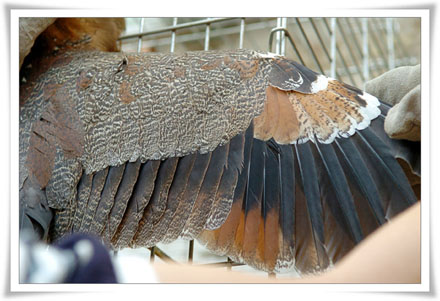
A Malayan Night Heron Gosachius melanolophus was apparently taken into captivity on June 4 in Gunsan after being injured by a cat.
Considering its distribution (well to the south of the Korean peninsula), its status as only a partial migrant, its plumage and its location, the species is for now being added to Category 3 of the Birds Korea checklist ("Species that have been reported since 1980, but whose origins are not proven to be wild"). Details on extralimital records of this species are being actively sought, as are opinions on age and plumage state etc.
The Gunsan City area , especially the Geum Estuary and offshore islands like Eocheong, has produced several outstanding records for South Korea, including several southern overshoots. It was, for example, the location of another suprise June southern overshoot in 2005 - a Lesser Coucal (a record soon followed by a second in 2006).
These images were posted on June 18 on the National Parks Migratory Bird Centre website, and are used with permission.
Songdo, June 18
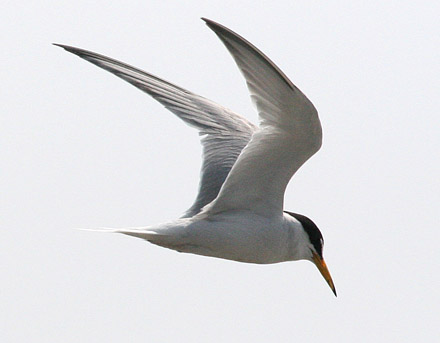
100+ Saunders Gulls and 40-50 Little Terns were foraging frantically to feed their young on the nearby colony, where several Meadow Buntings were heard singing. The terns seem to concentrate on diving for small fish in the water, while the gulls drop onto crabs and pull up mudworms from the mudflat.
Also 4 "Eastern" Oystercatchers & many Eastern Great Egrets on the shore. Only Spot-billed Ducks, Oriental Reed Warblers and 50 Great Cormorants remain at the lagoon.
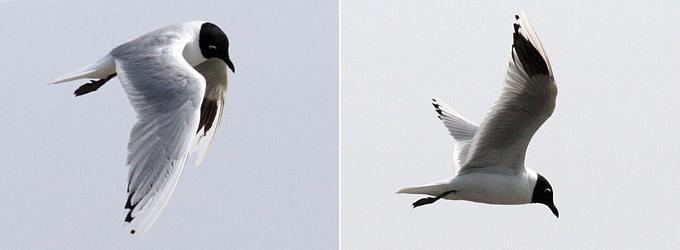
Soraesan, June 11
Thick woods here have provided brief views of a Brown Hawk Owl, Indian Cuckoo and Korean Hare Lepus sinensis coreanus in 2 visits this past week.
Namhansan, June 9
A trip to Southeast Seoul's Namhansan resulted in only a few birds seen, but several heard.
Heard only were 3 Oriental, 1 Hodgson's Hawk, 5 Indian, and 3 Eurasian Cuckoos. Also heard: Siberian Blue Robin, Asian Stubtail, and 3 Grey-backed Thrush.
Seen were a Chinese Sparrowhawk, a pair of Northern Hobbies, and a Hazel Hen.
Han Imjin and DMZ, June 6
A trip to restricted areas along the Han-Iimjin had a primary purpose of scouting/viewing ecologically valuable areas in parts of the DMZ, and this of course included some birding ...
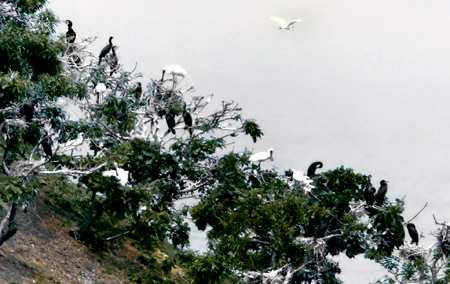
Highlights were 30+ nesting Black-faced Spoonbills at Yudo--a small and pristine island set against a backdrop of DPRK farmland. A perfect example of the immediate and pressing need to put into place real and extensive protection for priceless habitats that will be under immediate threat once reunification occurs. The Spoonbills were joined by numbers of Great Cormorants and a Chinese Pond Heron.
Also heard: a DPRK Eurasian Cuckoo!
Other highlights in the area were 5 Azure-winged Magpies, 12Mandarin Ducks very pretty in a rice-field, numerous Oriental Reed Warblers, 9 lingering Bean Geese, abundant Mal-dong Freshwater Crabs and 5 Korean Water Deer.
South of Cheorwon Basin and Song Do, Incheon, June 4
In the morning, excellent views of Black-capped Kingfisher and Chinese Sparrowhawk in good light, and 2 or more Ruddy Kingfisher heard at the same site. In the afternoon in Incheon, a typical mix of the fantastic (the birds) and the terrible (the habitat loss).
At Dongmak Lagoon, Song Do, the stunning male Pheasant-tailed Jacana, found by Tim Edelsten on June 3rd, was still present (there are only one or two records annually of this species in South Korea, with the most recent being one found and photographed by Ha Tae Seok on Gageo Island on May 28), along with at least 35 Black-faced Spoonbill (more than 2% of the world population) and 2 White Spoonbill (nationally rare in summer).
Meanwhile, the nearby Song Do tidal-flat is now pretty much "lost" - with bridge-building, dredging, and construction in full swing. The small area of apparently drying mud there still supported at least 99 feeding Saunders's Gull - more than one percent of the world population of this Vulnerable species, and the majority of adults of one of the only known breeding colonies of this species in the world.
Like Saemangeum, the Song Do reclamation, carried out this time at the height of the breeding season, can also be called sustainable development? A true balance of development with the environment, befitting the 10th biggest economy in the world in the 21st century?
June03, Cheorwon area and south
With the aim of seeing (and perhaps photographing) Black-capped Kingfisher, a day spent in or near the Cheorwon basin. In all, probably 4 or 5 Black-capped Kingfisher heard/seen, along with 2+ Ruddy Kingfisher heard. In addition, 2 Chinese Pond Heron, a late (or oversummering?) Grey-faced Buzzard, 50 Greater White-fronted and 3 serrirostris Bean Geese, 8+ Broad-billed Roller, 4+ Black-naped Oriole, and singing Eastern Crowned Warbler (1), Asian Stubtail (1) and Blue-and-White Flycatcher (4+)
Kunsan, Dong-kae Jang, June 3
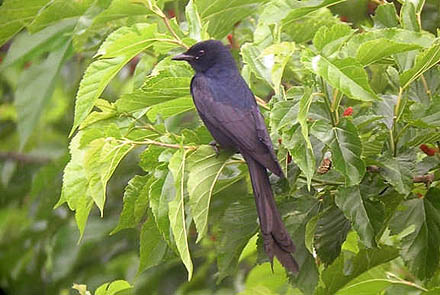
While exploring Dong-kae Jang village, I stopped by a field that was being prepared for rice planting. A Black Drongo flew from a nearby tree and perched. I watched it (and a good sample of other summer birds) for about an hour.
Songdo, June 3
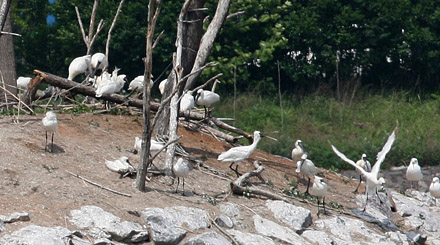
A superb male Pheasant-tailed Jacana presented itself in the centre of the lagoon today, quite boldly feeding in the open and giving good views. On the island, 28 Black-faced Spoonbills rested up, (their former roost on the nearby mudflat being demolished by bulldozers.)
1 Common Greenshank, 4 Kentish Plover and a Little Ringed Plover scuttled back and forth on the sandbar, also 2 Falcated Teal, 2 Mongolian Gulls, 42 Great Cormorant, a Eurasian Cuckoo (first heard on May 22), and Oriental Reed Warblers still singing from deep cover.
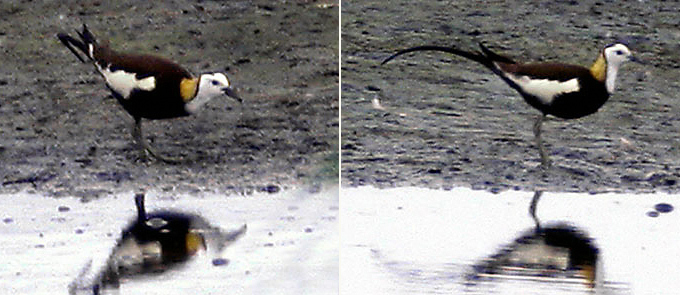
At Aham-do, 90-100 Saunders's Gulls, 1 (broken-winged) Bar-tailed Godwit, 5 "Eastern" Oystercatcher, 2 Black-crowned Night Herons, a good scattering of modesta "Eastern" Great Egrets, and a Whiskered Tern mingling with 44 Little Terns.
